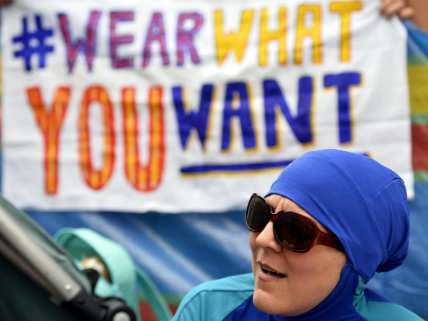Non-Religious Fundamentalists
Secular and socially-liberal Americans are blasting the French burkini bans. Yet when it comes to spreading "tolerance" here, will we get the message?


France's recent crackdown on a garment known as the "burkini," popular among Muslim women who want to remain modest while enjoying a swim, has accrued ample criticism from all over the world this week. But it's just one example of a wave of non-religious fundamentalism, in which the allegedly patriarchal print of Islam and other faiths must be destroyed by the righteous benevolence of public officials.
In Germany this week, a Muslim woman was fired from her government internship when she refused to remove her headscarf. In Tajikistan, a country long hostile to Islam, some officials have begun keeping lists of women who sport hijabs, the traditional head-covering worn by Muslim girls and women. "The country's staunchly secular authoritarian government disapproves of attire or grooming that would suggest supposedly radical Islamic beliefs," reports The Washington Post.
True, Tajikstan is an extreme example: its government has been known to shut down mosques at random, ban parents from giving their children Arabic names, and otherwise go hard on quashing religious expression. According to the U.S. Commission on International Religious Freedom, "the government of Tajikistan suppresses and punishes all religious activity independent of state control."
But France, an allegedly liberal and democratic country, also takes a pretty authoritarian line toward religious expression. Secularity is its own sort of religion there, at least to those in power, who have banned religious symbols such as crosses, yarmulkes, and hijabs in all government buildings and public schools. More recently, some 15 towns voted to ban burkinis on public beaches.
This week, the sight of French police publicly forcing a Muslim woman at the beach to remove clothing has (understandably) drawn a lot of outrage, with many rushing to point out why such policies go against the spirit in which they're intended. This takes the state at its word on why Muslim women's garments have been banned: they're a symbol of women's ongoing inequality in some cultures. That is not the culture of France, say leaders, and hence its zero-tolerance policy for such symbols of female oppression.
It's a silly scheme for several reasons. For one, it's unlikely to make the lives of actual oppressed women any better; for those whom husbands or families force headscarves and burquas in public, a ban on these items will simply mean many Muslim have to forgo the beach and other public outings entirely. (It's also unlikely to inspire goodwill among Muslim communities already alienated from mainstream French society.) For another, it's contradictory: in the name of women's equality, France is literally forcing women to wear less clothing than they're comfortable in and passing laws that target female attire but not male.
And these policies are also hypocritical in how they define symbols of female oppression. As many, many Muslim women have pointed out, hijabs and other traditional Muslim garments don't necessarily signify second-class status, and women may choose to wear them for cultural reasons or personal beliefs about modesty. Some folks counter that the "cultural reasons" are rooted in sexism, so what difference does it make? But surely we could say the same about many women's garments, from the habits worn by Catholic nuns to the wigs worn by Hasidic Jewish ladies to the stiletto-heels and string-bikinis worn by some secular women. Certainly not every woman who dons a skimpy outfits or slaps on bright-red lipstick is doing so to please men, or fulfill cultural norms, but many are, and you don't see France rushing to ban Forever 21 or L'Oréal.
But of course this is about more than just women's clothing. France's burkini-beach-party crackdown is rooted in a geopolitical zeitgeist that includes the rise of ISIS, the influx of Syrian immigrants to Europe, and the escalation of "lone-wolf" terrorist attacks in Western cities. The battle over burkinis, hijabs, and other outward symbols of Muslim womanhood has become a proxy battle for bigger conflicts over immigration and assimilation, terrorism and state control.
Emphasis on state control, though. While feminism and fear-of-terrorism may flavor this au courant crackdown—giving liberals and conservatives alike something to latch on to—the French ban on Muslim womenswear is based in good old-fashioned authoritarianism and toxic nationalism. The start of France's opposition to Islamic head-coverings came during the French-Algerian War of the 1950s and '60s, in which Algeria gained its independence after more than 100 years as a French colony.
At various times during this era, the French undertook campaigns to "liberate" Algerian women by making them remove their headscarves and veils, something Katherine Bullock details in Rethinking Muslim Women and the Veil. The last push came during Algeria's struggle for independence, as those who wanted the area to remain a part of France campaigned to convince Algerian women they were better off under French rule. In 1958, the French army rounded up around a hundred Muslim Algerians—mostly maids, sex workers, and other poor women—and unveiled them in a public square to cries of "Vive L'Algerie francaise!"
With that, the veil took on new significance as a symbol of anti-colonialist resistence. So, does that mean veiled French Muslim women are all subversive freedom fighters? Of course not. But it illustrates nicely how the same object or article of clothing can take on different meanings in different contexts, or hold multiple meanings for the same individual. Setting our Western gaze on women in hijabs and seeing only oppression isn't some new-fangled feminist awareness, it's a perfect extension of imperialist legacies.
At USA Today, Boston University religion professor Stephen Prothero points out that the U.S. was fond of exerting the same sort of state force against Catholics not too long ago. "In the late 19th century, several states passed laws, obviously aimed at Catholic nuns, that forbade teachers from wearing clerical garb in public schools," writes Prothero. "Today, such statutes remain on the books in Pennsylvania and Nebraska, where they effectively bar not only many Catholic clerics but also Muslim women with headscarves from serving as public school teachers."
Overall, however, separation-of-church-and-state took a different path in the U.S. than it did in France from the get-go. France set out to ensure the separation by more or less banning all religious expression in the public sphere, while the U.S. (generally) went the opposite route, stipulating that the state couldn't ban any particular public expression of faith. The result, writes Prothero, is that "a spiritual free market emerged. Here the power of any one denomination would be restrained by the presence of other denominations competing for adherents in full public view."
One only need look to the story of Catholics in America to see we got it right: once an outcast, suspicious, and non-assimilating crew, Catholics are now no less mainstream in America than apple pie. It turns out that when you let people assimilate at their own pace, picking and choosing from the dominant (liberal, secular) culture and their own smaller communities as they go along, most people will eventually begin to blend the two. The process can work in reverse, as well, with a minority group shifting dominant cultural views through time and tolerance—something we've seen in America over the past few decades when it comes to same-sex relationships and rights.
The lesson here for secular, socially-liberal Americans (and one I'm afraid few progressives pillorying France right now will entertain) is not to be like the burkini banners and other non-religious fundamentalists when it comes to spreading "tolerance" in America. Just as forcing French Muslims out of their comfort zones via state force has and will backfire, attempting to eradicate the last vestiges of homophobia, speed-up the destigmatization of transgender people, or otherwise encourage compassion, acceptance, and social tolerance through government force will always be a losing strategy.


Show Comments (100)